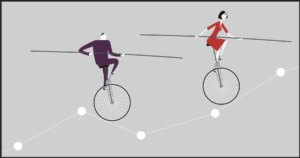
Many tools are available for assessing personality style, each having its nuance. With few exceptions, these assessments produce a matrix of 4 primary personalities.
These personality styles result from an understanding of extroversion vs. introversion and the relationship of each type to detail orientation. Add to this a person’s propensity to focus on an outcome or seek harmony.
In my experience, no matter what your leadership role is, knowing and understanding your own style and that of each person you work with is the key to achieving the results you want.
I recently had a conversation with a friend that drove this home for me again. My friend is an advisor to the CEO of a large company. This company is in the midst of a reorganization, and my friend is struggling with one of the new organization’s leaders. As we talked through the situation, it became clear to both of us that the root cause of her challenge was style. She is outcome-focused; he is harmony-focused; she is an introvert (goes within to process); he is an extrovert (processes out loud).
The result: he is talking too much from her perspective; she is trying to move the project forward; he has unresolved fears and is resisting.
Once she realized their style differences were causing her challenge, she had the answer; I could see it on her face. We then moved into a more extended discussion about the characteristics of each primary style and then a plan of action.
Bottom line. When I struggle to communicate, and I pause long enough to get some perspective, I’ve come to realize the answer always is: I need to modify my style to adapt to the other person’s style. Easier said than done, I know, and like everything else, it’s a journey.
 The initial results of my Pivot are excellent. I feel I have much greater clarity regarding the next 3-5 years..
The initial results of my Pivot are excellent. I feel I have much greater clarity regarding the next 3-5 years..  John Yerger
John Yerger